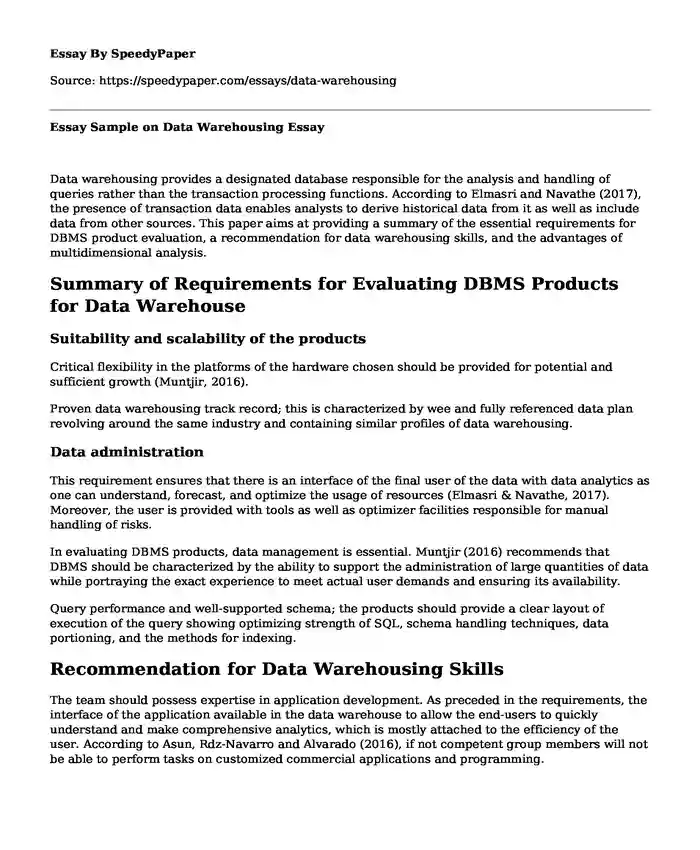
| Type of paper: | Essay |
| Categories: | Knowledge Data analysis Software |
| Pages: | 3 |
| Wordcount: | 655 words |
Data warehousing provides a designated database responsible for the analysis and handling of queries rather than the transaction processing functions. According to Elmasri and Navathe (2017), the presence of transaction data enables analysts to derive historical data from it as well as include data from other sources. This paper aims at providing a summary of the essential requirements for DBMS product evaluation, a recommendation for data warehousing skills, and the advantages of multidimensional analysis.
Summary of Requirements for Evaluating DBMS Products for Data Warehouse
Suitability and scalability of the products
Critical flexibility in the platforms of the hardware chosen should be provided for potential and sufficient growth (Muntjir, 2016).
Proven data warehousing track record; this is characterized by wee and fully referenced data plan revolving around the same industry and containing similar profiles of data warehousing.
Data administration
This requirement ensures that there is an interface of the final user of the data with data analytics as one can understand, forecast, and optimize the usage of resources (Elmasri & Navathe, 2017). Moreover, the user is provided with tools as well as optimizer facilities responsible for manual handling of risks.
In evaluating DBMS products, data management is essential. Muntjir (2016) recommends that DBMS should be characterized by the ability to support the administration of large quantities of data while portraying the exact experience to meet actual user demands and ensuring its availability.
Query performance and well-supported schema; the products should provide a clear layout of execution of the query showing optimizing strength of SQL, schema handling techniques, data portioning, and the methods for indexing.
Recommendation for Data Warehousing Skills
The team should possess expertise in application development. As preceded in the requirements, the interface of the application available in the data warehouse to allow the end-users to quickly understand and make comprehensive analytics, which is mostly attached to the efficiency of the user. According to Asun, Rdz-Navarro and Alvarado (2016), if not competent group members will not be able to perform tasks on customized commercial applications and programming.
Data modeling skills
Providing models and designs necessary for the presentation repositories and integration (Muntjir, 2016). Furthermore, the group should understand the difference between dimensional and relational data models.
The group should possess product automation skills. Since data warehouses are subject to periodic updates, data correctness and consistency are thus robust, and the personnel responsible for such should develop strategies such as built-in-fail-over (Asun et al., 2016), to allow users access most recent and available data.
Lastly, skills on data cleansing are primarily crucial in preventing the injection of quality issues into the new data during merging. These skills will enable the group to honor the hygiene of the data warehouse.
Multidimensional Data Analysis and Its Advantages
The multifaceted analysis incorporates data and molds it into exemplary exportable structures referred to as cubes, which then provide several dimensional views of the data (Muntjir, 2016). The furnished view then helps in providing critical reviews into the firm, thus improving how stakeholders make informed decisions.
The advantages of using multidimensional analysis include providing an exploration of information in a business context allowing users to make comparisons of different aspects like the customer, time, and religion (Elmasri & Navathe, 2017). It also gives insights into the performance of the business and adjustments made based on the trends. Moreover, the multidimensional analysis makes provisions of instant replies to frequently asked questions with the help of its core values on business factors.
References
Asun, R. A., Rdz-Navarro, K., & Alvarado, J. M. (2016). Developing multidimensional Likert scales using item factor analysis: The case of four-point items. Sociological Methods & Research, 45(1), 109-133. DOI: 10.1177/0049124114566716
Elmasri, R., & Navathe, S. (2017). Fundamentals of database systems. Pearson. Available online: https://storm.cis.fordham.edu/~yli/documents/CISC3500Fall17/FinalProject.pdf
Muntjir, M. (2016). Novice Evaluation and Comparative Survey on Database Management System, Data Warehousing, and Data Mining. International Journal of Computer Applications, 136(10), 39-45. Available online: http://citeseerx.ist.psu.edu/viewdoc/download?doi=10.1.1.740.2941&rep=rep1&type=pdf
Cite this page
Essay Sample on Data Warehousing. (2023, Mar 22). Retrieved from https://speedypaper.net/essays/data-warehousing
Request Removal
If you are the original author of this essay and no longer wish to have it published on the SpeedyPaper website, please click below to request its removal:
- Application Example for Master's Degree in Information Technology
- The Court System - Free Essay in Law
- Race and Ethnicity in Society Essay, Free Example for Everyone
- Free Essay on Education Matter: Public Schools Education Reform
- Essay Example on Book Critique: Action Speaks by Paul Green
- Free Essay: A Concept of Interest on Classical Realist Theories of International Relations
- Free Essay in Finance: Amazon Financial Performance and Health
Popular categories




